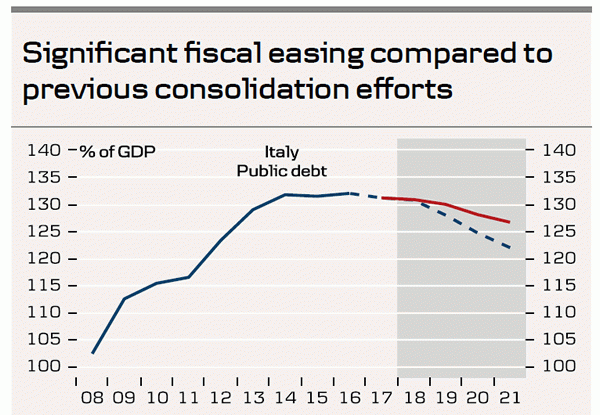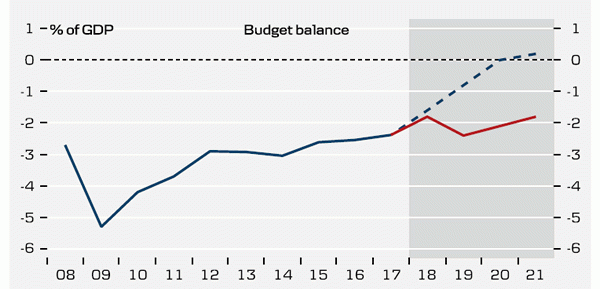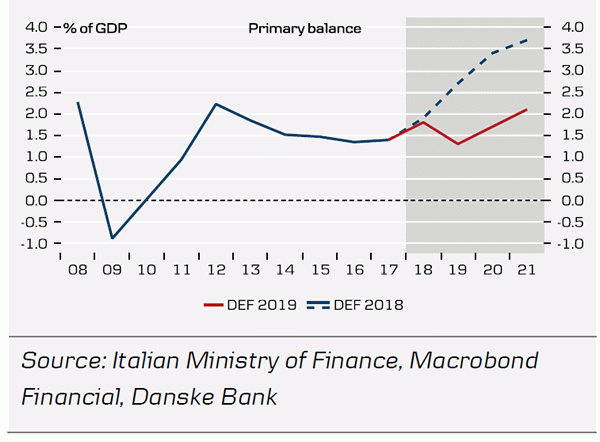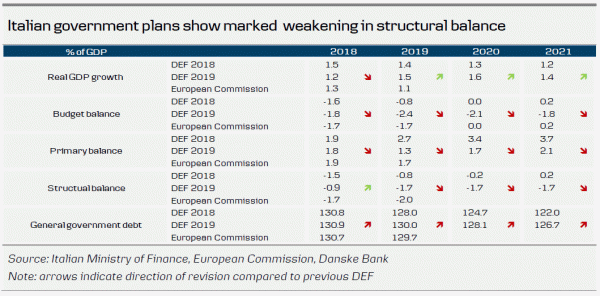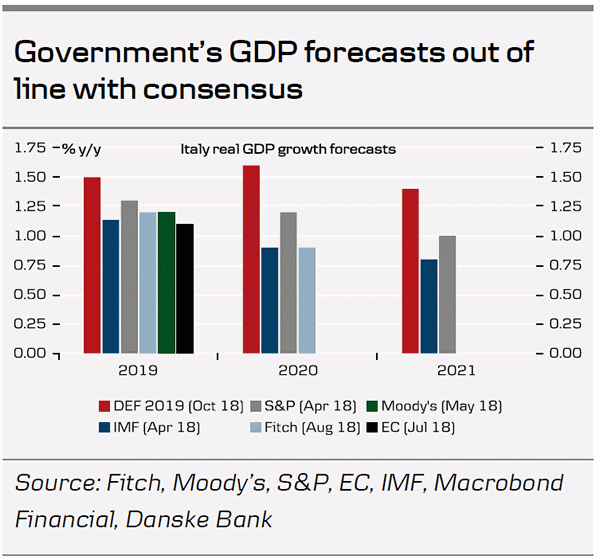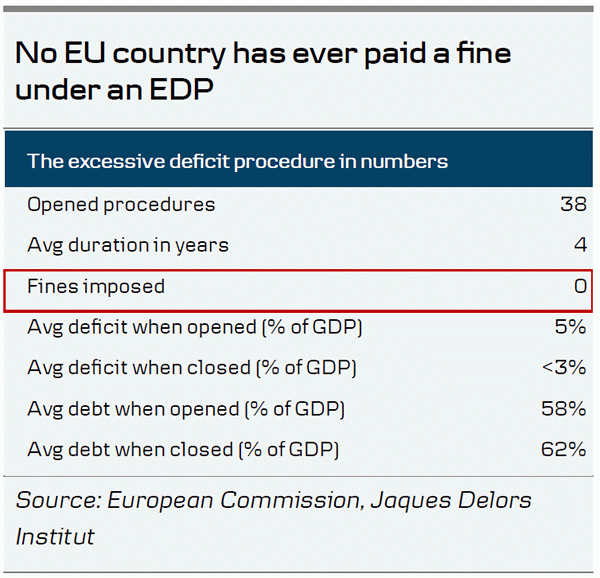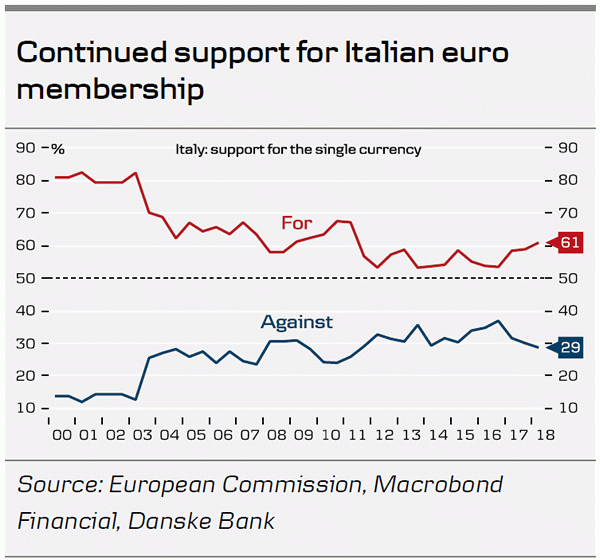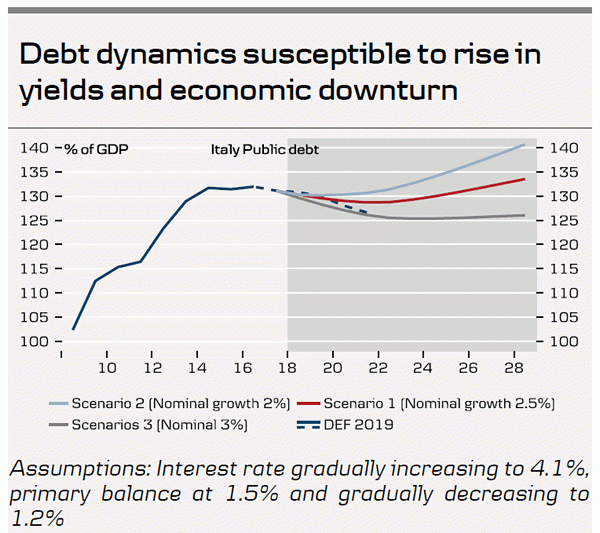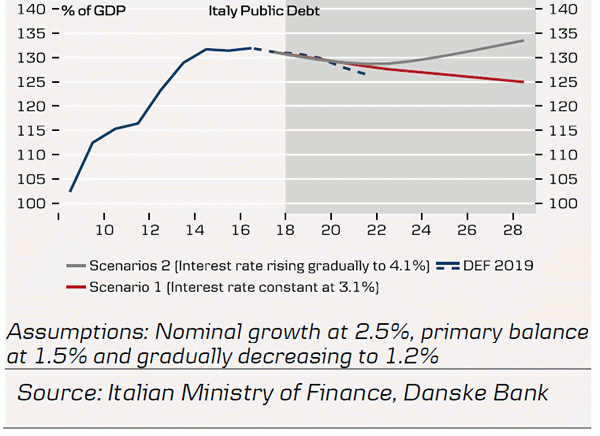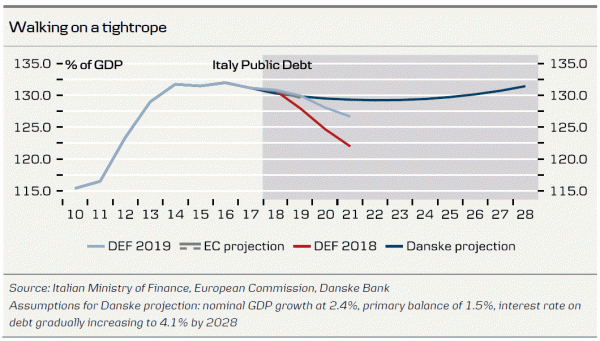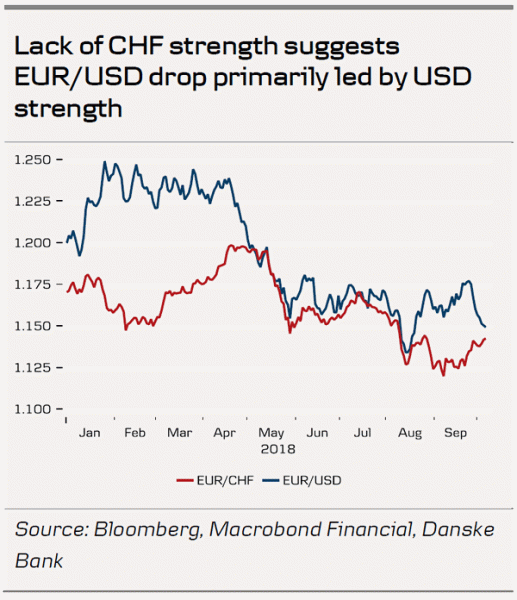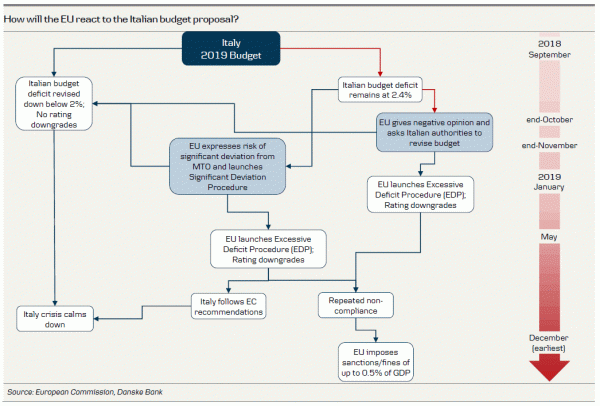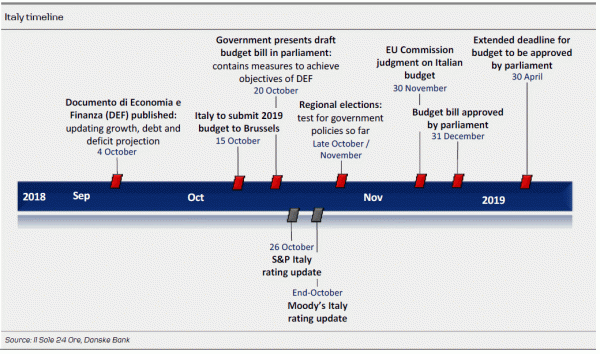- Italian budget plan is based on optimistic growth and interest rate assumptions, while the revenue side remains vague.
- Our base case is now that the EU Commission will give a negative viewpoint and ask for a revision of the budget, which risks triggering a populist backlash, but it will be a long road until EU sanctions are imposed.
- One should not be complacent about Italian risks in the medium term, as the debt dynamics remain susceptible to a downturn in growth and/or rise in yields.
- While ‘Italian fiscal noise’ may weigh on EUR /USD at times in the near term, we stress that USD positives remain more important.
Following last week’s compromise reached on the 2019 budget deficit, the government has now finally released the full Economic and Financial Document (DEF) outlining the details and assumptions behind its new fiscal strategy.
Efforts by Finance Minister Tria to promote his government’s new fiscal strategy to his euro area counterparts ended in failure on Monday and Commission President Juncker warned of a Greek-style crisis. Tria sought to explain his government’s decision to breach the requirement of a structural balance improvement of 0.6pp in 2019 in the context of slower growth in the euro area and Italy and stressed that the deficit will still envisage a decline – although limited – in the debt-to-GDP ratio. However, senior European Commission officials have been unyielding and signalled that the planned deficit target would be considered a breach of EU fiscal rules.
The Italian budget projections are not yet set in stone (the parliamentary discussion on the fiscal plan started on Wednesday). In light of tough language from Brussels and President Mattarella’s reported refusal to sign off on a deficit of 2.4% over three years, the government relented and lowered the planned 2020 and 2021 deficits to 2.1% and 1.8%, respectively. The president has already on previous occasions indicated that he will play an active role in ensuring debt sustainability and he has the right to veto government bills that are deemed unconstitutional and significantly violate the balanced budget requirement according to Art. 81.
The DEF reveals that the government plans significant fiscal easing compared to the previous administration. The budget projections are based on the four building blocks of a citizen income and pension reform (EUR17bn), the first phase of a ‘flat tax’ scheme (so far mainly targeting small businesses) and higher public investments (EUR4-6bn). The DEF remains notably very vague on the financing side. Mentioned financing measures include cutting expenses for ministries (EUR4bn) and changes in subsidy schemes, tax deductions and improved tax compliance. Existing funds for the ‘Inclusion Income Scheme’ (REI) will also be used to finance the new citizen income. But, overall, permanent revenue measures remain broadly absent from the draft, although the document hints at only a ‘partial’ cancellation of the VAT hike for 2020 and 2021 subject to reassessment after the 2019 Stability Programme. Due to these uncertainties on the financing side, we see a clear risk that the 2019 deficit could end up even higher than 2.4%.
The DEF acknowledges that the debt ratio would exceed the Commission’ debt-rule benchmark by 3.9pp in 2021. Furthermore, the projected decline in the debt-to-GDP path is based on optimistic growth forecasts and the assumption of stable debt servicing costs. On Wednesday, Confindustria, the Italian employers’ organisation, projected GDP growth at 1.1% this year and 0.9% next year. Although some of the measures such as the flat tax for SMEs and public investment should have a positive growth effect if implemented appropriately, growing signs of economic slowdown and lingering structural issues as well as higher Italian and global yields will continue to hamper Italy’s growth outlook, in our view.
Apart from high growth assumptions, the envisioned significant weakening in the 2019 structural balance by 0.8pp (with zero improvement 2019-21) instead of a required improvement of 0.6pp will been seen as particularly concerning by the Commission. This together with the vague revenue measures and latest noises from the EU side, means that our base case (>50% probability) now is that the Commission will choose the ‘hard approach’ of voicing a negative opinion and request for a revised budget within two weeks after the submission deadline of 15 October (see scenarios below). Afterwards, the Italian authorities will again have three weeks to oblige with the request and, in case of non-compliance, could proceed by opening an Excessive Deficit Procedure (EDP) against Italy, maybe as soon as the beginning of 2019.
A negative reaction from the EU is likely to trigger some noise in the market, but we still think the EU’s hands are somewhat tied in terms of credible sanctions powers, also because of a cumbersome and lengthy procedural process until fines of up to 0.5% of GDP can be imposed on a country violating the EDP recommendations repeatedly. Furthermore, no EU country placed under an EDP so far has ever paid a fine.
A greater risk, in our view, is that a budget policy seen as dictated by Brussels will trigger a populist backlash at home with euro-sceptic tones again gaining prominence among League and Five Star leaders and unnerve markets. That said, we still see a very low probability of an actual Italian euro exit in the future, not least due to the dire economic and financial consequences, continued (and recently increasing) support for the single currency among the Italian population and the lengthy constitutional process of holding an actual euro-exit referendum.
We still think it is more the market reaction and development in Italian yields that will make the government rethink its fiscal strategy and ultimately determine the probability of an Italian debt crisis in the future. Italian government bond yields – as well as the spreads over German bonds – remain at the highest level since 2014. Despite the envisioned budget deficit increase, the government’s fiscal plan still projects a primary surplus of 1.3-2.1% in 2019-21. This is important for the debt outlook, because average interest rates on public debt in Italy continue to exceed nominal GDP growth (a negative ‘snowball effect’) and hence the primary surplus needs to compensate for the adverse dynamic in the growth-interest rate differential. As long as the government can maintain a primary budget surplus of around 1.5%, public debt will at the current stage not escalate out of control, even if growth moderates back to 0.9% and borrowing costs rise moderately over the coming years.
That said, one should not be complacent about Italian risks in the medium-term in our view, as the debt dynamics remain susceptible to a downturn in growth and/or rise in debt servicing costs, especially on the back of further rating downgrades. Such a vicious cycle of fiscal slippage, political uncertainty, a clash with the EU and higher yields as seen during the European debt crisis remains the biggest risk. However, at the current stage we still see a relatively low probability for an Italian debt crisis erupting within the next two years (20%).
EUR/USD: amid the ‘Italian noise’, mind the USD support
EUR/USD has come under renewed pressure over the past week and broke through 1.15 again yesterday. While Italy worries have been weighing at times with the FX weathering the risk of an Italian exit from the eurozone, we think that USD support has been a key factor as well. Notably EUR/CHF – usually a good bellwether of euro risks – has been edging higher during the same period. A US economy that is still going-strong and a Fed that is willing to add to the carry in USD still. Despite the ECB’s growing confidence in an inflation pick-up, we still think it is too early for the EUR uptrend, which we continue to see potential for in 2019, to be re-ignited. While ‘Italian fiscal noise’ may weigh at times near term, we stress that USD positives remain more important in keeping EUR/USD in a range around 1.15 and fuel tests of this year’s low (1.1301) ahead of year end. However, such dips should be bought into.




